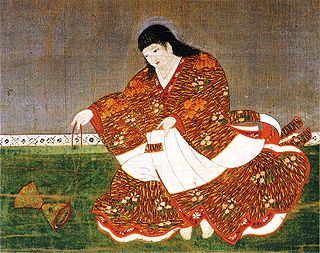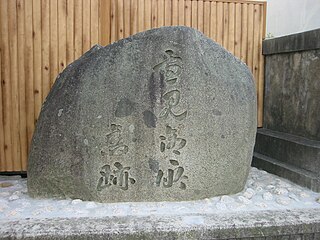Related Research Articles
Year 1183 (MCLXXXIII) was a common year starting on Saturday of the Julian calendar.

Year 1185 (MCLXXXV) was a common year starting on Tuesday of the Julian calendar.

Emperor Antoku was the 81st emperor of Japan, according to the traditional order of succession. His reign spanned the years from 1180 through 1185. His death marked the end of the Heian period and the beginning of the Kamakura period.

The Genpei War was a national civil war between the Taira and Minamoto clans during the late Heian period of Japan. It resulted in the downfall of the Taira and the establishment of the Kamakura shogunate under Minamoto no Yoritomo, who appointed himself as Shōgun in 1192, governing Japan as a military dictator from the eastern city of Kamakura.

The Tale of the Heike is an epic account compiled prior to 1330 of the struggle between the Taira clan and Minamoto clan for control of Japan at the end of the 12th century in the Genpei War (1180–1185).

The Battle of Dan-no-ura was a major sea battle of the Genpei War, occurring at Dan-no-ura, in the Shimonoseki Strait off the southern tip of Honshū. On April 25, 1185, the fleet of the Minamoto clan (Genji), led by general Minamoto no Yoshitsune, defeated the fleet of the Taira clan (Heike). The morning rip tide was an advantage for the Taira, but turned to their disadvantage in the afternoon. The young Emperor Antoku was one of those who died among the Taira nobles.

The battle of Kurikara Pass, also known as the battle of Tonamiyama (砺波山), was a crucial engagement in Japan's Genpei War; in this battle the tide of the war turned in the favour of the Minamoto clan.

The Battle of Ichi-no-Tani was fought between the offensive Minamoto clan and the defensive Taira clan at Suma, to the west of present-day Kobe, Japan, on 20 March 1184. It sat on a very narrow strip of shore, between mountains on the north, and the sea to the south. This made it quite defensible, but also made it difficult to maneuver troops inside the fortress. The Taira suffered a crucial defeat to the forces of Minamoto no Yoshitsune and Minamoto no Noriyori.

Battle of Yashima (屋島の戦い) was one of the battles of the Genpei War on March 22, 1185, in the Heian period. It occurred in Sanuki Province (Shikoku), which is now Takamatsu, Kagawa.

Taira no Koremori was one of the Taira clan's commanders and military lord during the Genpei War of the late Heian period of Japanese history. He was the only child of Taira no Shigemori, who was the eldest regent and heir of Taira no Kiyomori.

Taira no Munemori was heir to Taira no Kiyomori, and one of the Taira clan's chief commanders in the Genpei War.

Taira no Noritsune was a military leader of the late Heian period of Japan. He was the son of Taira no Norimori. He fought in the Genpei War against the Minamoto clan.

Kajiwara Kagetoki was a samurai and retainer of the Kamakura Shogunate during the late Heian and early Kamakura period. He was a spy for Minamoto no Yoritomo in the Genpei War, and a warrior against the Taira clan. He came to be known for his greed and treachery. He was a prominent eastern warrior and supplied Minamoto no Yoshitsune with a number of ships after the Battle of Yashima.

Nasu no Yoichi was a samurai who fought alongside the Minamoto clan in the Genpei War. He is particularly famous for his actions at the Battle of Yashima in 1185. According to the Heike Monogatari, the enemy Taira placed a fan atop a pole on one of their ships, daring the Minamoto warriors to shoot it off. Sitting atop his mount in the waves, his target atop the ship rocking as well, Nasu nevertheless shot it down with only one shot.

Yashima was a Fuji-class pre-dreadnought battleship built for the Imperial Japanese Navy (IJN) in the 1890s. As Japan lacked the industrial capacity to construct such vessels, the ship was designed and built in the United Kingdom. She participated in the early stages of the Russo-Japanese War of 1904–1905, including the Battle of Port Arthur on the second day of the war. Yashima was involved in subsequent operations until she struck two mines off Port Arthur in May 1904. The ship did not sink immediately, but capsized while under tow later that day. The Japanese were able to keep her loss a secret from the Russians for over a year.

Fukuhara-kyō was the seat of Japan's Imperial Court, and therefore the capital of the country, for roughly six months in 1180. It was also the center of Taira no Kiyomori's power and the site of his retirement palace.

The Aibiki River is a river located in Takamatsu, Kagawa, Japan.

Satō Tsugunobu was a Japanese warrior and the brother of Satō Tadanobu. Tsugunobu died in the Battle of Yashima, while protecting Minamoto Yoshitsune from an arrow shot of Taira no Noritsune by riding between Yoshitsune and Noritsune. Tsugunobu was buried in Mure, Kagawa, by Taira no Noritsune.
Minamoto no Yoshikiyo was a Japanese samurai military commander, feudal lord, and courtier in the late Heian period of Japan's history. He took part in the Genpei War as a general for Minamoto no Yoshinaka, leading Yoshinaka's army against the Taira clan at the Battle of Mizushima where he was defeated and perished. His descendants would go on to form the Hosokawa clan and gain influence and power during the Ashikaga Shogunate and the subsequent Sengoku and Edo Periods as Daimyo.

Kazusa Hirotsune was a samurai lord and gōzoku in Kantō during the late Heian period. He was the head of the Bōsō Taira clan and fought against the Taira clan on Minamoto clan's side during the Genpei War. He is commonly also known as Kazusa-no-suke Hirotsune, in which "Kazusa-no-suke" indicates his office.
References
- ↑ Sansom, George (1958). A History of Japan to 1334. Stanford University Press. p. 296. ISBN 0804705232.
- ↑ Turnbull, Stephen (1998). The Samurai Sourcebook. Cassell & Co. p. 202. ISBN 1854095234.